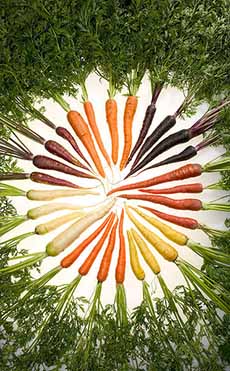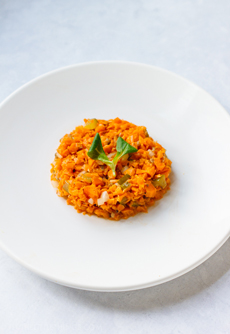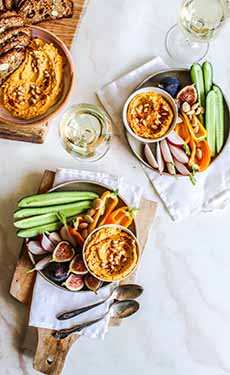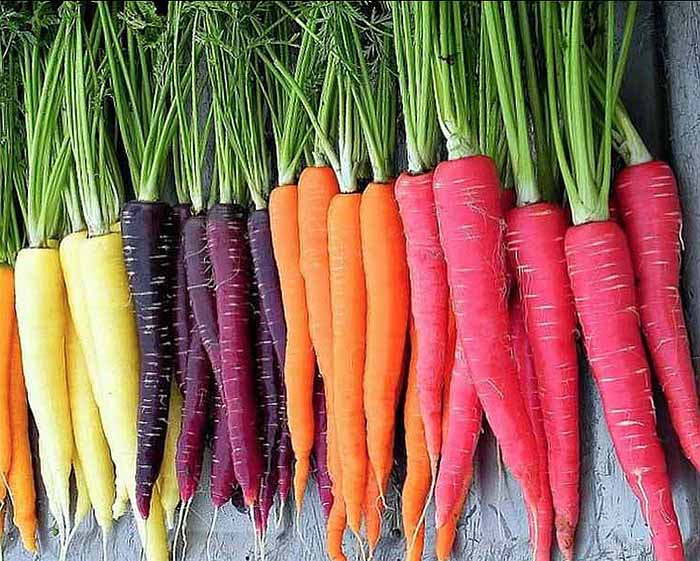|
Baby carrots are hot sellers. But how much hotter can they get than these rainbow baby carrots?
Carrots—standard size and baby—are available in six different colors: the familiar deep orange plus burgundy red, deep purple, tangerine (light orange), yellow and white.
They’re a delicious way to add color and crunch to appetizers, salads and entrées. Kids and adults alike love them for their unusual colors—and for helping make family nutrition into fun.
Deeply colored produce are rich in nutrients, including antioxidants. Different antioxidants produce the different colors or carrots. More about that in a minute. But first…
A VERY BRIEF CARROT HISTORY
The original wild carrots were white, like parsnips. According to Colorful Harvest, marketer of these rainbow carrots, the cultivated purple and yellow carrots—mutations—were eaten more than 1,000 years ago in what is now Afghanistan.
Other colors are the product of generations of traditional plant breeding. Orange carrots were first successfully bred in Holland from an orange mutation by Dutch farmers.
> Here’s more history of carrots.
> International Carrot Day is April 4th.
> See all the carrot holidays below.
> Also below, 20+ yummy carrot recipes.
WHERE DO CARROTS GET THEIR COLOR?
From phytonutrients! Studies indicate that these phytonutrients are also more bio-available and easier to absorb from fresh fruits and vegetables than from other sources.
Red carrots get their color from lycopene, an antioxidant that may promote healthy eyes and a healthy prostate.
Orange and tangerine carrots get their color comes from beta-carotene, an antioxidant and precursor of vitamin A.
Purple carrots get their color from anthocyanins, the same potent phytonutrients (antioxidants) that makes blueberries blue,. Anthocyanins are flavonoids that may help increase the antioxidant capacity of the blood and may help maintain good brain function.
Yellow and white carrots get their color from lutein, which studies suggest may promote good eye health.
25 CARROT RECIPES
25 Uses For Carrot Tops
Braised Moroccan Chicken With Farro-Carrot Salad
Carrot & Sweet Potato Tzimmes
Carrot Fries, Baked Or Air-Fried
Carrot Hummus
Carrot Latkes (Potato Pancakes)
Carrot Oil Made From Carrot Peelings
Carrot Raisin Slaw
Carrot Tartare
Carrot Top Pesto
Carrot Salad With Global Variations
Corned Beef & Cabbage Broth Bowl
Curried Carrot Soup
Fall Salad
More Ways To Enjoy Carrots
Moroccan Quinoa & Roasted Carrots
Peas & Carrots Canapés
Rainbow Mashed Potatoes
Roasted Whole Carrots
Shredded Salads
Spiced Roasted Carrots With Sumac
Summer Crudités (A Modern Relish Tray)
Vegetable Crudo
Veggie Hash Browns
THE YEAR’S CARROT HOLIDAYS
February: National Snack Food Month
February 3: National Carrot Cake Day
March 10: National Pack Your Lunch Day
April 4: International Carrot Day
June 17: National Eat Your Vegetables Day
October 1: World Vegetarian Day
October 2: National Produce Misting Day
November is National Roasting Month
Plus:
April 30: National Bugs Bunny Day
September, 4th Saturday: International Rabbit Day
|
|

[1] Rainbow carrots from Colorful Harvest (photo by Elvira Kalviste | © THE NIBBLE).

[2] A rainbow of carrot (photo by Stephen Ausmus | Wikimedia.

[3] Carrot tartare, a fun recipe (photo via The Little Things | Pinterest).

[4] Carrot hummus. Here’s the recipe (photo © Discover California Wine).

[5] Moroccan Roasted Carrots & Quinoa. Here’s the recipe (photo © Good Eggs)
|








